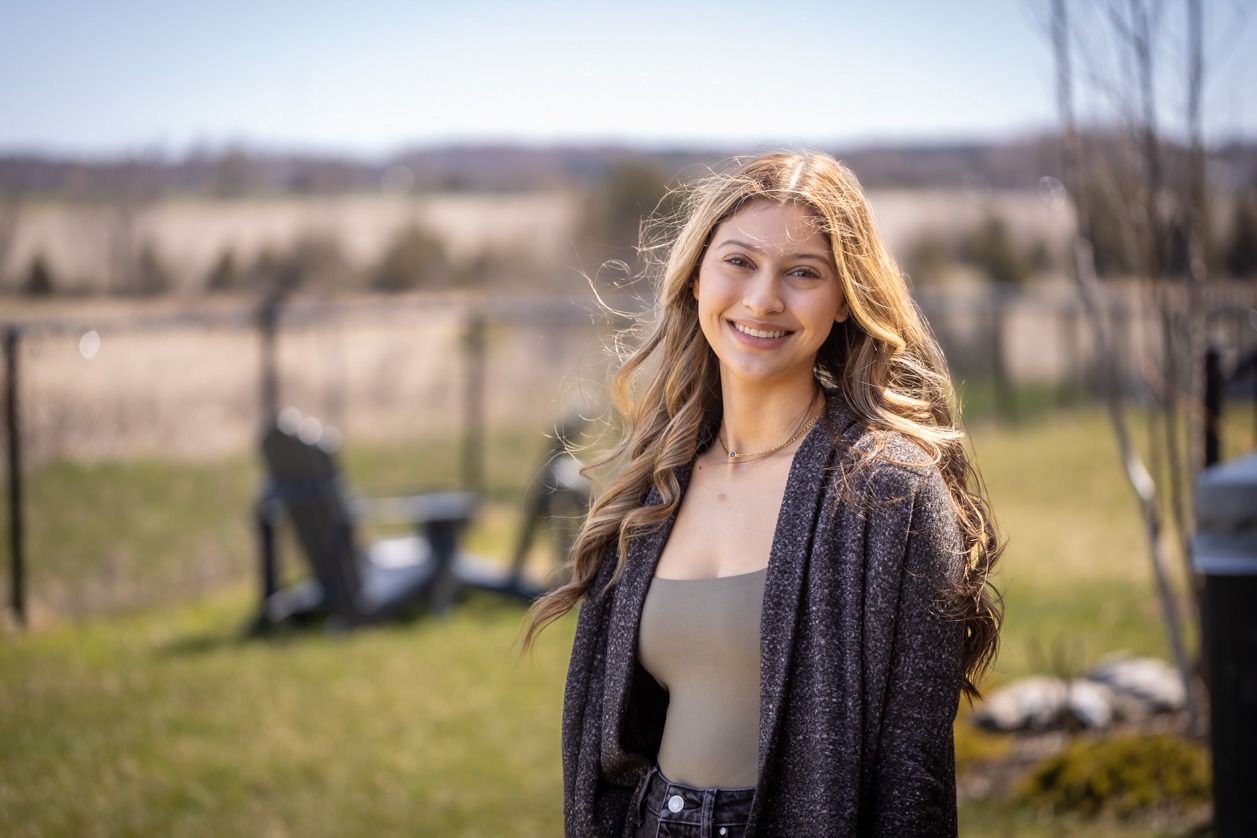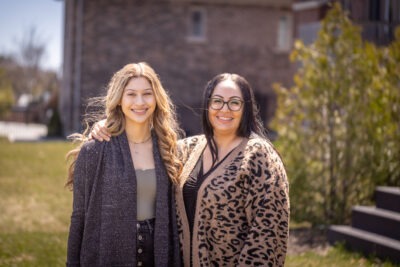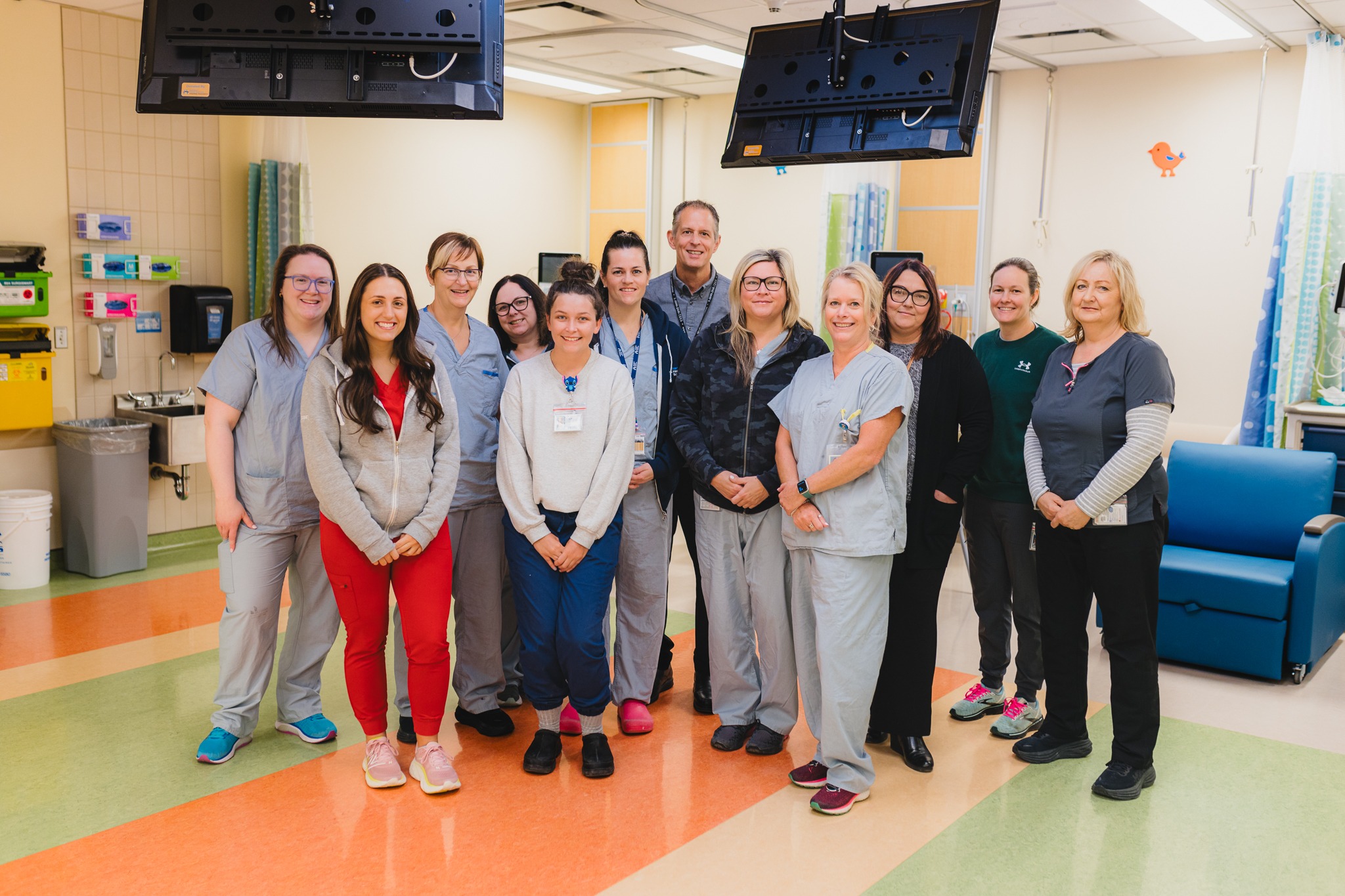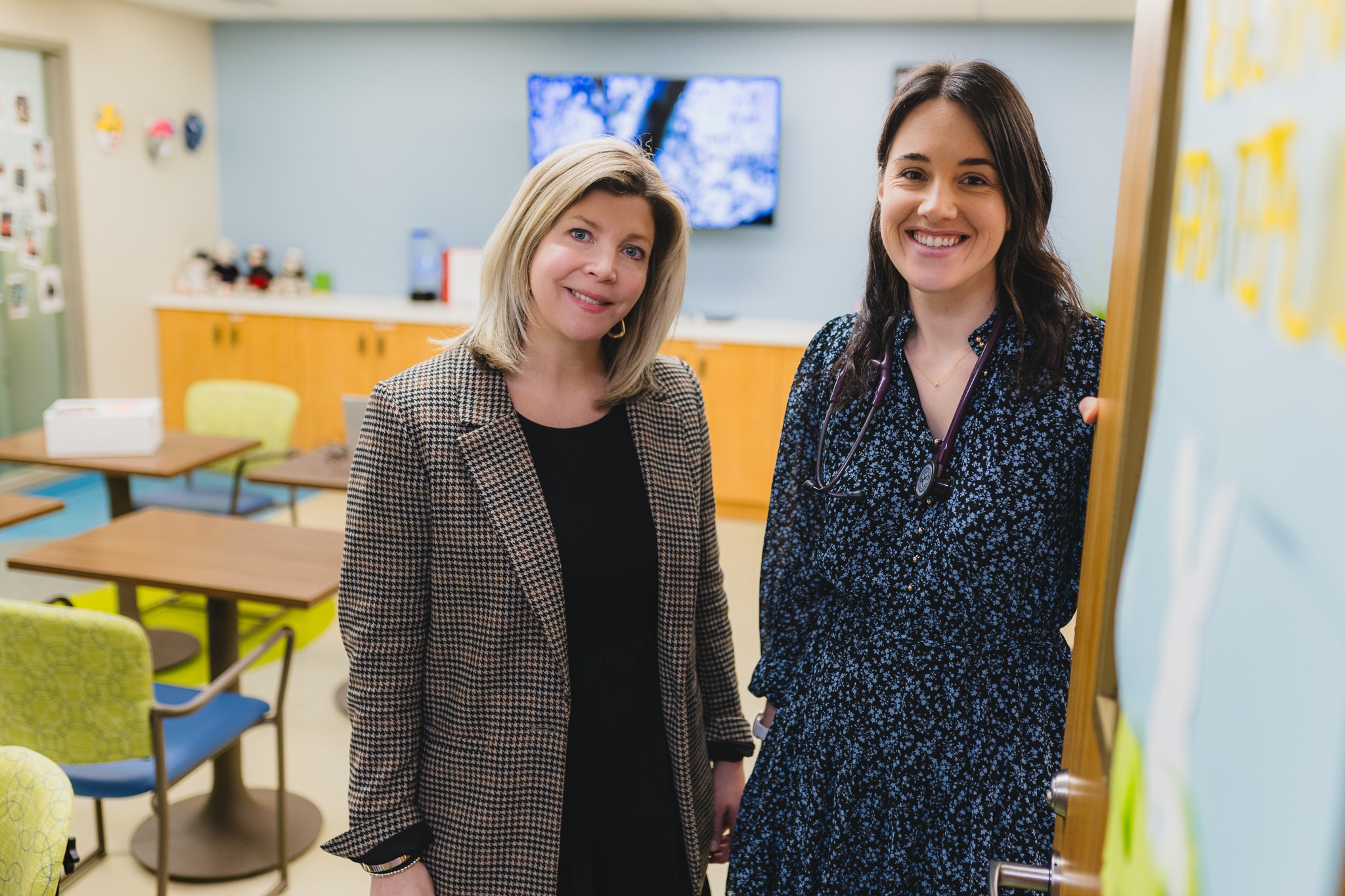
Believing in Katie: MCH team’s mind-body approach to a painful rare condition
Orangeville teen Katie Mantione grew up as an active child doing competitive figure skating, dance, skiing and school sports. When activities resumed after pandemic-related closures in 2022, Katie was 16 years old and in grade 10. She embraced the opportunity to immerse herself in school and teen life, getting her G1 driver’s licence, starting a part-time job, and joining her sister to play on their high school’s rugby team.
The first rugby game went well, but everything changed in the second game. Katie rolled her ankle, and another player landed on top of it when she was tackled. And then, not a minute later, another player stepped on her.
Katie immediately lost feeling in her right foot. Emergency medical service providers at the game suggested going to the local emergency department for investigation and treatment.

Katie and her mom, Anna
“I was telling them I can’t feel my foot. It literally feels like there’s nothing there. They took an x-ray and said it’s a mild sprain and suggested I keep it wrapped, apply ice and elevate,” said Katie.
Three days passed, and Katie’s foot was very painful, swollen, purple and always freezing cold.
At the suggestion of a co-worker, Anna, Katie’s mom, took her daughter to McMaster Children’s Hospital (MCH) emergency department, an hour-long drive away from the family’s home.
Further imaging was done and confirmed there was no structural injury. The emergency room doctor suggested Katie had complex regional pain syndrome (CRPS), a rare chronic condition where the nervous system amplifies an injury causing excessive pain even after the initial injury has healed.
While Katie’s initial injury was only a sprain, her nervous system had created an exaggerated response. The doctor suggested physical therapy to get her foot moving as quickly as possible.
For weeks, Katie went to physiotherapy, but nothing the therapist tried could make Katie’s foot move nor could she feel any sensation.
Denial and depression
At home in Orangeville, Katie’s condition was misunderstood despite the diagnosis. Health care providers and school peers questioned how Katie could have a chronic condition. Katie and her family continued to seek other opinions and referrals.
“Everyone until this point kept looking for a different explanation. They were saying, ‘No, it can’t be complex regional pain syndrome’,” said Katie.
As weeks went by after the initial injury, Katie’s foot remained the same – painful, swollen, immobile and cold. The condition became a life-threatening mental health issue for Katie.
“My foot was just hanging there. I don’t know how many times I wished they would just amputate it. Everything in my life was just all of a sudden taken away. Dance and rugby were taken away. I couldn’t drive anymore. I couldn’t really walk except on crutches, so I didn’t go anywhere. I had to stop working and quit my job,” said Katie.
“I basically isolated myself and didn’t hang out with friends for almost six months. I became known as ‘crutch girl’ at school. I was getting more frustrated, more depressed, more isolated.”
“But right away, the clinic understood and treated me like a whole person – mind, body and soul.”
When Katie returned to school after the summer on crutches, she faced more denial and bullying.
“The number of people at school saying to me, ‘Oh, you’re faking it. It’s not that big a deal.’ They said I was too young to have chronic pain and that I was attention-seeking,” recalls Katie.
When extreme pain sent Katie and her mom back to MCH emergency department for pain management, another doctor, who had a focus on sports medicine, immediately reconfirmed Katie‘s diagnosis, referring to it as a ‘classic’ case of complex regional pain syndrome.
The doctor optimistically told Katie and her mom that medication and alternative therapies could help. She was temporarily seen at Hamilton Health Sciences’ Michael G. DeGroote Pain Clinic for the management and treatment of chronic pain until a spot in the McMaster Children’s Hospital Pediatric Pain Program became available.

After Katie suffered a sprain from playing rugby, she used crutches to help her walk.
MCH pediatric chronic pain program: a team approach to the mind and body
On their first visit to MCH’s pediatric chronic pain program (PCPP), Katie and her mom were immediately put at the heart of a team that included Dr. Sheri Findlay, adolescent medicine specialist and medical director of the PCPP, social worker Rebecca Zamani, physiotherapist Jillian McJannet, psychiatrist Dr. Laura Rosato and Kirsten Frank Colwell, occupational therapist. Together, the team heard Katie and Anna’s experiences, created goals and determined roles and responsibilities of each clinic member.
For two years, the team helped Katie learn coping strategies to manage her pain and return to the life and activities she enjoyed. The PCPP team’s care and support also extended to parenting support for Anna so that she could learn strategies to support Katie’s physical and mental health needs.
“I have this magical pain that won’t go away, and I’m dealing with severe mental health struggles all the time. I just felt like I was crazy. But right away, the clinic understood and treated me like a whole person – mind, body and soul. They said, ‘Don’t worry, Katie, you’re going to be able to move your foot again,’” said Katie.
Long, hard work
“The hardest thing for me to comprehend was my foot wasn’t going to be fixed overnight. Healing was going to be a really long, emotionally draining process,” said Katie.

Kirsten Frank
As an occupational therapist (OT), Kirsten Frank Colwell’s role combines physical and mental health interventions to help children at the clinic regain their health, engage in meaningful activities and improve their overall well-being.
Prior to receiving funding from the provincial government, the PCPP had one occupational therapist who focused specifically on supporting children’s needs at school. With the investment of $48 million to support MCH’s programs and services, the team was able to hire Frank Colwell and increase the number of children the two OTs see, enabling them to focus on a wider range of goals to provide the best care.
“As OTs, the activities we do either contribute to or impact both physical and mental health. Some of the kids we see in the clinic are in bed all day, on their phones, not sleeping, or doing anything. We explore what those barriers are – pain is obviously a really big barrier, as are low mood, low motivation, and worries,” said Frank Colwell.
“My focus was to help Katie understand that the brain and body are one system and to help her engage in activities she wants to do through daily routines,” she added.
Some of Frank Colwell’s physical approaches included pacing strategies as a form of pain management in Katie’s valued activities, including dance, rugby, and skiing. They looked at ways to gradually expose and re-introduce these activities, discussing management strategies and jointly practicing movements alongside her physiotherapist.
“Pacing is a significant intervention we do in clinic, as it allows youth to participate in those activities they want and need to do but works to build their tolerance up in small increments over time, and focuses on positive experiences,” said Frank Colwell.
An altered sensation in my brain
Frank Colwell’s support also extended into the school, where she worked closely with the principals and teachers to make accommodations so Katie’s environment could best support her healing process. For example, Katie had two lockers, one close to her morning classes and another locker close to her afternoon classes. She was also allowed to get up and walk around class or do a lap up and down the hallway because sitting for a long time would trigger a pain flare.
Katie and her OT also worked to develop coping strategies and assertive communication skills to support conversations with peers or teachers to explain her situation and needs.
“The pediatric pain clinic was our saving grace. They were the ones who gave us hope.”
Jillian McJannet, Katie’s physiotherapist, focused techniques such as graded motor imagery where Katie would look at her foot in a mirror as she tried to move it to gradually restore her range of motion and bear weight. McJannet also introduced Katie’s foot to different sensations and textures, such as dragging a cotton ball across her foot, and assigned her homework to practice at home.
Together with her OT and her social worker, Rebecca Zamani, Katie learned essential skills such as relaxation-based strategies and activities that improve her mood and support her in developing self-efficacy, self-confidence, and the ability to distract herself from pain flare-ups.
“No amount of pain medication helps in those moments. It’s an altered sensation in my brain. I learned mindful meditation, breathing, and deep breathing techniques to distract me. My mom was also my distractor extraordinaire, turning on music, putting a TENS unit on my leg, or taking me out for a drive,” said Katie.
Throughout their time with the PCPP, Kirsten Frank Colwell was a conduit between the team and Katie and Anna. The entire care team was always a phone or video call away, with Drs Findlay or Rosato adjusting medications and supporting the family at the toughest moments when Katie experienced suicidality and severe depression.
“The clinic team were our safe place. We felt confident to tell them your true feelings and what was going on because they actually understand you when you feel like you’re going crazy,” said Katie.
Back on her feet

Two years later, Katie has the skills to cope with her illness thanks to MCH’s Pediatric Chronic Pain Program.
Together, after a year of intensive work, the team helped Katie get off the crutches and back on her feet – mentally and physically.
CRPS will be part of Katie’s life forever as the condition can flare up with stress and anxiety. She’s now 18 years old and graduated from the MCH PCPP having learned the skills and tools to manage the condition. She will continue to receive chronic support at the Michael G. DeGroote Pain Clinic.
“When we first met Katie, the goal was just for her to get to school and be able to walk around school without crutches. It was such a pleasure to see her go from not being able to walk on her foot, to going out into the world and looking forward to enrolling in a nursing program. She’s such a confident young woman,” said Frank Colwell.
While in the waiting room for the MCH pediatric pain program for the first time, Katie and her mom remember a picture on the wall that simply said ‘Hope’.
“The pediatric pain clinic was our saving grace. They were the ones who gave us hope. The team was so positive. They told me it was going to be okay and that they’d help me find ways to cope, deal with, and handle all the challenges that come up. And they did,” said Katie.



